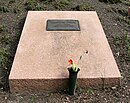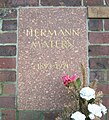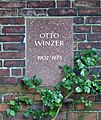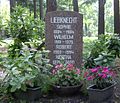Memorial of the Socialists
The memorial of the socialists is a grave and memorial site within the central cemetery Friedrichsfelde in Berlin . The complex, officially inaugurated in 1951, together with the adjoining Pergolenweg grave complex, served as a cemetery of honor for people who had rendered outstanding services to the socialist idea during the GDR era . It follows on from the tradition of the Friedrichsfelde cemetery as a burial place for the labor movement, which began in the late 19th century.
History of the memorial and its predecessors
Friedrichsfelde becomes a socialist cemetery
When the central cemetery Friedrichsfelde was opened in 1881, the burial of the poor was also possible here for the first time in Berlin because the city paid the costs. In August 1900, the Friedrichsfelde Central Cemetery became known throughout Germany when the SPD founder Wilhelm Liebknecht was buried here. At his burial, around 150,000 people formed a funeral procession from Charlottenburg to Friedrichsfelde. Because Paul Singer , Ignaz Auer , Emma Ihr and other Social Democrats were later buried there, the cemetery was soon nicknamed the Socialist Cemetery . The burial place of most of these people, which was set up directly at the main entrance, was located on a slight hill, which political supporters colloquially called Feldherrnhügel .
The Berlin magistrate had not approved the burial of all 33 victims of the Spartacus uprising (January 5 to 12, 1919), including the killed KPD founder Karl Liebknecht , in the cemetery of those who fell in March , which is why on January 25, 1919 after a mass demonstration by the Berliners Downtown and a mass rally at the central cemetery Friedrichsfelde the dead were buried in a mass grave. A few days later, other revolutionaries who had now been identified were laid to rest here, including Leo Jogiches . He was a friend of Rosa Luxemburg , who was also killed and whose body could not be found at first. A woman's body recovered from the Landwehr Canal on May 31, 1919 was later referred to as that of Luxembourg and buried on June 12, 1919 in the grave field of the dead of the Spartacus uprising. The Berlin workers appeared in large numbers for a funeral procession through the eastern Berlin districts.
Revolution monument from 1926

In memory of the KPD leaders killed in 1919 as well as the victims of the Reichstag unrest of 1920 and a few other revolutionaries from the workers' movement who died later, a revolutionary monument was to be erected at the Friedrichsfelde central cemetery . This plan was pursued by its own monument committee, which was formed on the initiative of Wilhelm Pieck . The foundation stone was laid on June 15, 1924 . However, there were still no clear ideas about the appearance and, above all, the financing of a monument. All supporters of the communists were called upon to make proposals in connection with the holding of a party congress in 1925. As a basic idea, a design by Auguste Rodin could be presented, which was called The Outrage and depicted a bronze statue ( Genie de la Guerre ) in front of a wall. The wall served as a symbol both for the suppression of the revolution in France in 1871 and for the solidarity with the Soviet Union and the revolutionaries buried at the Kremlin wall. The memorial was not realized in this form. Instead, Ludwig Mies van der Rohe designed a memorial for Karl Liebknecht and Rosa Luxemburg and the revolutionary monument with the essential element of a wall made of protruding and recessed hard-fire bricks on behalf of the art patron and KPD functionary Eduard Fuchs . Mies van der Rohe, whose father was finally a stone setter, later explained (also to the McCarthy Committee ) that Fuchs had given him the contract after Mies had described an existing monument design as a "banker's monument" which was unsuitable for the revolutionaries. The sculptor Herbert Garbe was also involved in the design and later the construction .
Workers from Bauhütte Berlin erected the monument in the spring of 1926, which was unveiled on June 13, 1926 - still unfinished because the money raised was insufficient. In the following weeks, the simple clinker brick building was completed at the site of the laying of the foundation stone and officially inaugurated on July 11, 1926. The communists Ernst Meyer , Paul Schwenk and Paul Scholze as well as the member of the Socialist League Georg Ledebour gave speeches to the participants of the inauguration ceremony. Until 1933, parades and commemorations in honor of Lenin, Liebknecht and Luxemburg (referred to as "LLL Weeks") took place in the cemetery at the Revolution Monument. In February 1933, the National Socialists began to destroy the memorial by tearing down the five-pointed star and the flagpole. At the beginning of 1935, the rulers had the building stripped down to its foundations and the graves leveled.
After the end of the Second World War , the destroyed revolutionary monument was not restored. However, the tradition of the memorial marches and rallies were revived, for which purpose a provisional replica of the van der Rohe building was erected in 1946.
There have been repeated initiatives to permanently reconstruct the destroyed memorial from 1926–1935. A Liebknecht-Luxemburg-Gesellschaft, founded in West Berlin in 1968, tried for some time to have the van der Rohe memorial rebuilt in the Tiergarten . Numerous supporters such as the social democrats Kurt Neubauer , Walter Sickert and humanities scholars such as Wolfgang Abendroth , Ernst Bloch or Walter Jens did not manage to obtain funding. The architect also refused to give his consent. So this idea did not materialize.
In 1982 a plaque based on designs by Günther Stahn (architect) and Gerhard Thieme (sculptor) was set up on its original location with the inscription: “The revolutionary monument for Karl Liebknecht, Rosa Luxemburg and many other revolutionary fighters of the German labor movement stood on this foundation . Erected in 1926 by the Communist Party of Germany based on plans by Ludwig Mies van der Rohe. ”This memorial is on the Berlin list of monuments.
In 2004, on the occasion of the 80th anniversary of the laying of the foundation stone, a symposium took place on questions of the history of the design and destruction of the revolutionary monument. Mies van der Rohe's relationship to the communist labor movement, the archive and files on the memorial and general questions of the culture of remembrance were also discussed.
Every year since the killing of the two revolutionary leaders Liebknecht and Luxemburg, the Socialists' Day of Remembrance has been held on the second Sunday in January . Wreaths, but mostly red carnations, are laid on the graves of the socialists. In the GDR, the day also served as a large-scale demonstration for and by the GDR government.
New memorial from 1951
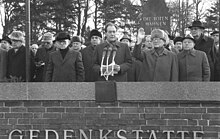
Instead of restoring the destroyed revolutionary monument from 1926 after the end of the Second World War in its old form, the East Berlin magistrate organized an ideas competition in 1947 for a complete redesign of the facility. Among other things, the garden architect Herta Hammerbacher participated . The first prize was awarded to a working group consisting of the garden designer Walter Rossow , the architect Ludwig and the sculptor Gustav Seitz . On May 26, 1948, the magistrate decided to build a memorial for the “Great Socialists”. In September 1949, the magistrate then gave the order to build a joint memorial for social democrats and communists in the front part of the central cemetery in Friedrichsfelde. However, the facility has now been designed by the architects Hans Mucke and Richard Jenner and the garden architect Reinhold Lingner . To clear the building site, the mausoleum of the von Bleichröder banking family of Jewish descent was razed. The grave sculptures by Hans Latt from that time have been lost since then. The redesign work including the relocation of the coffins took place from 1950 under the direction of the city councilor Arnold Munter . During the construction work, older grave slabs, tombstones and steles by prominent social democrats and communists from the time of the monarchy and the Weimar Republic were also moved to the location of the new memorial. Also in 1950 the Politburo of the SED decided to bury other personalities of the workers' movement in the memorial. This should be done in the form of urns, which should be buried either in the ring wall of the memorial itself or in the adjoining Pergolenweg grave.
On January 14, 1951, in the presence of leading GDR politicians such as Wilhelm Pieck , Friedrich Ebert junior and Erich Honecker , the new facility was inaugurated in its current form under the name of the Socialist Memorial . Until the end of the GDR, the memorial and Pergolenweg served as the GDR's cemetery of honor . The SED Politburo reserved the right to decide who should receive an honorary grave here. The selection of those honored in this way therefore particularly reflects the history of the GDR .
History since the end of the GDR
Since the German reunification in 1990, no new graves have been allocated in the memorial of the socialists. However, the urns of family members of those people who were buried there before 1989 can still be buried in the Pergolenweg grave complex.
The Liebknecht-Luxemburg-Demonstrations held annually at the memorial during the time of the GDR have been continued since 1990 by an alliance of various left-wing groups, parties and individuals.
In 2005, the Lichtenberg district was about to close the memorial site. Due to the underground warm air heating , the large stone slabs had shifted seriously. The support group for the memorial site of the German labor movement in Berlin-Friedrichsfelde , founded in 2000, managed to organize money for the renovation and also to equip the cemetery with a wayfinding system and information boards.
- Memorial stone for the victims of Stalinism
On December 11, 2006, next to the “Memorial of the Socialists”, a memorial stone with the inscription “The Victims of Stalinism ” was erected, which is intended to expand the canon of remembrance to include the Socialists and Communists who were killed, imprisoned or handed over to the National Socialists during the Stalinist terror. The stone was inaugurated by the President of the Berlin House of Representatives, Walter Momper, and the PDS District Mayor of Berlin-Lichtenberg, Christina Emmrich . Momper described the stone as a necessary addition, which is explicitly no counterpart to the other memorial. He added that the stone “knows no restrictions or exclusions”: “The inscription 'To the victims of Stalinism' includes all victims. And that's how it should be. Because you can't just remember individual groups of victims and leave others out. ”Emmrich connected the stone with the history of her party, especially with the break with the“ Stalinism as a system ”of the SED-PDS in the winter of 1989. The memorial stone was especially popular the communist platform of the PDS, which as the largest faction in the Lichtenberg district council party was politically responsible for the line-up, was controversial for various reasons. The stone was financed and erected by the “Support Group Memorial Site of the German Labor Movement”. During the demonstrations, the stone was often spat at and violated.
Architecture and construction of the memorial
Location and additions
The memorial, inaugurated in 1951, is located immediately to the right of the main entrance to the cemetery behind a large gravel square. The system is circular, its diameter is about 25 meters. Its outer boundary is a four-meter-high clinker wall, while the central point of the memorial is formed by an approximately four-meter-high stele made of Rochlitz porphyry with the inscription “The dead remind us” .
In the central roundabout around this stele, the SED Politburo had the commemorative plaques for ten particularly important people from the labor movement installed. The clinker brick wall surrounding the memorial contains older grave slabs, tombstones and steles of prominent social democrats and communists from the time of the monarchy and the Weimar Republic , which were transferred here when the memorial was rebuilt from 1950 onwards. In addition, the urns of numerous other personalities are located in this wall, Kurt Fischer being the first to be buried here in 1951.
Tombs and monuments in the roundabout
Immediately around the porphyry stele with the inscription “The dead admonish us” , ten memorial plaques on the floor commemorate the following personalities:
| Surname | Inscription, read clockwise | image |
|---|---|---|
| Rosa Luxemburg | "Rosa Luxemburg murdered January 15, 1919" | |
| Karl Liebknecht | "Karl Liebknecht murdered January 15, 1919" | |
| Ernst Thalmann | "Ernst Thälmann murders August 18, 1944" | |
| Rudolf Breitscheid | "Rudolf Breitscheid murdered August 24, 1944" | |
| Franz artist | "Franz Künstler murdered September 10, 1942" | |
| Franz Mehring | "Franz Mehring died January 28, 1919" | |
| John Schehr | "John Schehr murdered February 1st, 1934" | |
| Walter Ulbricht | "Walter Ulbricht died August 1st, 1973" | |
| Otto Grotewohl | "Otto Grotewohl died September 21, 1964" | |
| Wilhelm Pieck | "Wilhelm Pieck died September 7, 1960" |
However, not all of these people are actually buried at the memorial. Otto Grotewohl's urn was first buried in the curtain wall when he died in 1964; his grave slab was twice as large as the others. It was only when Ulbricht was buried in 1973 that the grave slabs were arranged in a circle and Grotewohl was reburied. Before that, the grave slabs were placed in a rectangle. Up to 1973 there were only 9 grave slabs, two pieces each on the right, left and back, three pieces for Luxemburg, Liebknecht and Pieck in front. Pieck and Ulbricht were buried in the Rondell immediately after their deaths, Schehr and Mehring were subsequently transferred here and Breitscheid's grave is located in the south-west cemetery in Stahnsdorf , which was made by artists at the Baumschulenweg cemetery . Thälmann's body is missing, and it is not absolutely certain whether the body found as Rosa Luxemburg is really that of the dead worker leader. However, when the memorial was laid out at the original burial site at the revolutionary monument, no remains of Karl Liebknecht and Rosa Luxemburg were found (unlike Franz Mehring). Regardless of the discussion as to whether Luxembourg was actually buried in Friedrichsfelde in 1919 or not, the last five named here in the memorial of the socialists are symbolic graves.
Tombs and monuments on the curtain wall
Along the inside of the curtain wall, tombstones, tombstones and steles from different epochs remind of the following representatives of the German and international socialist labor movement and social democracy (in alphabetical order):
Ignaz Auer , Friedrich Bartels , Adolf Braun , Eugen Brückner , Richard Fischer , Hugo Haase , Adolph Hoffmann , Emma Ihr , Alwin Körsten , Carl Legien , Theodor Leipart , Wilhelm Liebknecht , Waldeck Manasse , Hermann Molkenbuhr , Hermann Müller-Franken , Adolf Ritter , Paul Singer , Johannes Stelling , Margarete and Robert Wengels , Klara and Hermann Weyl , Luise Zietz and Fritz Zubeil .
Klara and Hermann Weyl
Graves in the curtain wall
In wall niches, which are closed with uniform red stone slabs, the urns of the following people can be found (in alphabetical order):
A total of 71 urns are incorporated behind the panels, including six by women. With the exception of a few politicians from the post-war period , all of those honored here were active in the anti-fascist resistance.
Large plaque
In addition to the urn sites, on the right side of the curtain wall there is a large memorial plaque made of red Löbejun porphyry with the names of the dead and murdered from the Weimar Republic , from the Spanish civil war and 327 people who died in the anti-fascist resistance 1933–1945 . In front of this nameplate there is an urn collecting grave with the ashes of some of these people. Among the personalities buried here are u. a. Alfred Kowalke , Michael Niederkirchner , Hermann Stickelmann , Walter Stoecker , Karl Vesper and Hans Zoschke .
Pergolenweg grave complex
The Pergolenweg grave complex is located outside the actual memorial site for the Socialists. The grave complex begins immediately behind the circular wall of the memorial and extends on the eastern side of the cemetery towards the celebration hall. This area was not originally intended for honorary graves, but has been gradually adapted for this purpose since 1951. The burial also took place in urns (a maximum of four per grave), but - in contrast to the memorial - the spouses and close relatives of the honored personalities could also find their final resting place here. The wives of numerous people are also buried on Pergolenweg, whose urns are located in the circular wall of the memorial .
Currently (as of the 2010s) this complex includes around 350 grave sites with over 500 dead, including (in alphabetical order):
Most of the people buried on Pergolenweg took an active part in the resistance against the Nazi dictatorship and the war, in illegality and prisons, in many countries of emigration as well as in the armed forces of the anti-Hitler coalition . They belonged to the SPD, KPD, KPO , SAPD and other political currents and groups. They came from different professions and ethnic groups, including parliamentarians, trade unionists, academics, journalists and artists. Quite a few of them suffered Stalinist repression in the former Soviet Union or were discriminated against by the SED in the 1950s. Other GDR leaders are also buried here, including some well-known State Security officers.
Hilde , Georg and Michael Benjamin , Erich Jungmann
Descendants of Wilhelm Liebknecht
Markus and Konrad Wolf
The adjoining cemetery for anonymous burials, on which Erich Mielke's urn was buried, does not belong to the Pergolenweg complex .
literature
- Heinz Vosske : History of the memorial of the socialists in Berlin-Friedrichsfelde . Dietz Verlag, Berlin 1982.
- Joachim Hoffmann : Berlin-Friedrichsfelde. A German national cemetery - cultural and historical travel guide . Das Neue Berlin, Berlin 2001, ISBN 3-360-00959-2 .
- District Office Lichtenberg of Berlin (ed.): The revolutionary monument by Ludwig Mies van der Rohe. Berlin 2013.
Web links
- Friedrichsfelde Central Cemetery
- Socialist cemetery
- Detailed description of the memorial of the socialists ( Memento of July 4, 2013 in the Internet Archive )
Individual evidence
- ↑ a b c d Joachim Hoffmann: Berlin-Friedrichsfelde. A German national cemetery - cultural and historical travel guide. Das Neue Berlin, Berlin 2001, ISBN 3-360-00959-2 .
- ^ Paul Singer Association (ed.): At the foundation stone of democracy. The revolution of 1848 and the cemetery of the March dead. Brochure for the exhibition in the cemetery of the March fallen, Berlin 2011, p. 30.
- ↑ NGBK : "Who Owns the World?" Berlin 1977; there: R.-P. Baacke, M. Nungesser: “I am, I was, I will be!” ; there: D. D. Egbert: quoted Mies in the 1960s: “One of the first houses I build was for Hugo Perls in Berlin. Mr. Perls sold his house in the early twenties to a Mr. Edward Fuchs. [...] After discussing his house problems Mr. Fuchs then said he wanted to show us something. […] It was a huge stone monument with Doric colums and medallions of Luxemburg and Liebknecht. When I saw it I started to laugh and I told him it would be a fine monument for a banker. […] The next morning he called me […] ”.
- ↑ as above, NGBK: “Who owns the world?” ; there source Rote Fahne from June 15, 1926.
- ↑ Gudrunstraße, memorial to the revolutionary monument from 1926
- ^ Wita Noack (Mies van der Rohe House) on the history of the monument ( Memento from July 3, 2009 in the Internet Archive )
- ↑ Luxemburg-Liebknecht-Demo: Memorial procession on its own behalf (December 11, 2011)
- ↑ 3 sheets on the new memorial for the socialists by Herta Hammerbacher
- ↑ Resting place of our fighters / redesign on the Friedrichsfeld cemetery . In: Neues Deutschland from February 1, 1948, p. 3.
- ↑ a b c Answer to the written question in the Berlin House of Representatives on the subject of the Socialist Memorial (II) of August 20, 2018 .
- ↑ Walter Bartel: Memorial of the Socialists . In: Neues Deutschland from January 13, 1952, p. 6.
- ↑ Address by the President of the House of Representatives Walter Momper on the inauguration of the memorial stone for the victims of Stalinism
- ^ Website of the support group memorial site of the German workers' movement Berlin-Friedrichsfelde eV
- ↑ Stalin is not a classic ( Memento of the original from February 27, 2014 in the Internet Archive ) Info: The archive link was inserted automatically and has not yet been checked. Please check the original and archive link according to the instructions and then remove this notice. , Communications from the Communist Platform, February 2007
- ↑ http://www.stadtmorgen.de/politik/liebknechtluxemburgkundgebung-rangelei-mit-gegendemonstranten/37722.html
- ↑ A lot of information in the daily news of 2009.
Coordinates: 52 ° 30 ′ 56 ″ N , 13 ° 30 ′ 38 ″ E


















